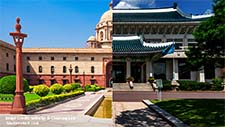Pyongyang’s ‘weapons first, negotiations later’ strategy
Sangsoo Lee
On 9 September 2016, the US Geological Survey detected a 5.3-magnitude earthquake in the area of North Korea’s Punggye-ri underground test site. Four hours later, North Korean state television announced that it had successfully detonated a nuclear warhead. Based on the seismic waveforms, the blast is estimated to have been about 10 kilotons — more than twice as large as the recent test in January and is the most powerful test conducted so far by North Korea.
A more significant revelation from the test is the rapid progress that North Korea has made in developing their nuclear technology. According to the Korea Central News Agency (KCNA), the test ‘finally examined and confirmed the structure and specific features of movement of [a] nuclear warhead that has been standardised to be able to be mounted on strategic ballistic rockets’.
This article was first published here on ISDP Voices.
Related Publications
-
South Korea’s Indo-Pacific Strategy, Atmanirbhar Bharat, and the IPEF: Convergence and Commonality
For some time now, the existing multilateral networks such as those of the United Nations (UN) system have been largely ineffective in providing good global governance and helping create resilience, […]
-
Seoul’s Changing Indo-Pacific Manifesto and India: Policy Prescriptions for India-ROK Ties
Abstract: China’s stupendous rise and the subsequent rivalry with the US for global hegemony have forced countries to choose sides; caught between a rock and a hard place, middle powers […]
-
South Korea’s Foreign Policy in Changing Times: Reversing Course?
Abstract: The tragedy currently unfolding in Ukraine may be a symptom of new dynamics in global geopolitics. The changing balance of power epitomized by the rise of China and the […]


